The Skylake Core i3 (51W) CPU Review: i3-6320, i3-6300 and i3-6100 Tested
by Ian Cutress on August 8, 2016 9:00 AM ESTLinux Performance
Built around several freely available benchmarks for Linux, Linux-Bench is a project spearheaded by Patrick at ServeTheHome to streamline about a dozen of these tests in a single neat package run via a set of three commands using an Ubuntu 11.04 LiveCD. These tests include fluid dynamics used by NASA, ray-tracing, OpenSSL, molecular modeling, and a scalable data structure server for web deployments. We run Linux-Bench and have chosen to report a select few of the tests that rely on CPU and DRAM speed.
All of our benchmark results can also be found in our benchmark engine, Bench.
C-Ray: link
C-Ray is a simple ray-tracing program that focuses almost exclusively on processor performance rather than DRAM access. The test in Linux-Bench renders a heavy complex scene offering a large scalable scenario.
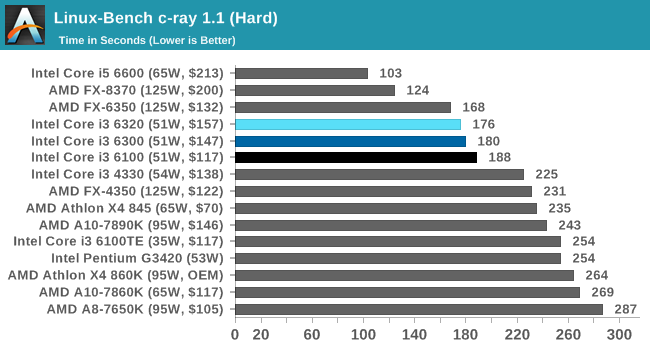
C-Ray is another bench that likes threads and high IPC cores, hence the i5-6600 sits out ahead followed by the FX-8350. At a lower price bracket, the FX-6350 with six threads wins out against the set of Core i3s, which follow their regular staircase pattern. The difference in frequency accounts for 4 seconds difference, and it seems the L3 cache difference accounts for another 4, or about 2%.
NAMD, Scalable Molecular Dynamics: link
Developed by the Theoretical and Computational Biophysics Group at the University of Illinois at Urbana-Champaign, NAMD is a set of parallel molecular dynamics codes for extreme parallelization up to and beyond 200,000 cores. The reference paper detailing NAMD has over 4000 citations, and our testing runs a small simulation where the calculation steps per unit time is the output vector.
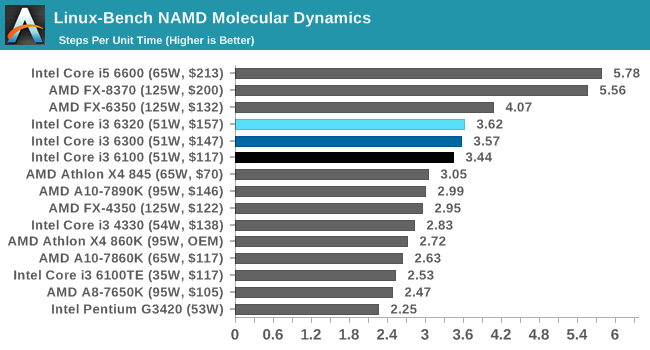
Similarly with NAMD, cores and IPC matter most. The Athlon X4 845 gets a good showing here for a $70 chip, beating the price/performance ratio of the Core i3s. Again, the AMD FX-6350 is ahead of the Core i3s, and the lopsided staircase means that the L3 cache difference accounts for another 2% loss in performance.
NPB, Fluid Dynamics: link
Aside from LINPACK, there are many other ways to benchmark supercomputers in terms of how effective they are for various types of mathematical processes. The NAS Parallel Benchmarks (NPB) are a set of small programs originally designed for NASA to test their supercomputers in terms of fluid dynamics simulations, useful for airflow reactions and design.
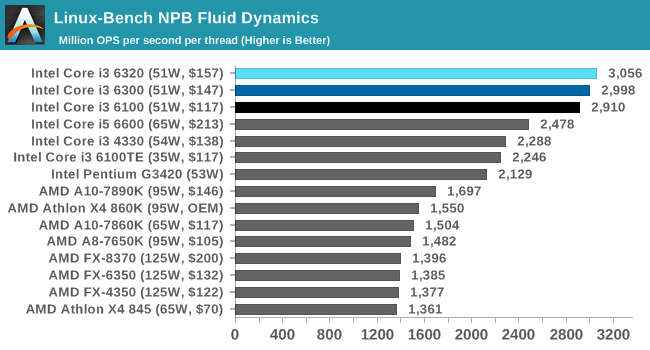
NPB clearly favors Intel CPUs, and the name of the game is IPC and frequency due to the i5 being behind the Core i3 parts. On the AMD side, the highest frequency part takes the lead and the thread count doesn't seem to matter much; neither does the microarchitecture, indicating that NPB is likely tuned for Intel.
Redis: link
Many of the online applications rely on key-value caches and data structure servers to operate. Redis is an open-source, scalable web technology with a strong developer base, but also relies heavily on memory bandwidth as well as CPU performance.
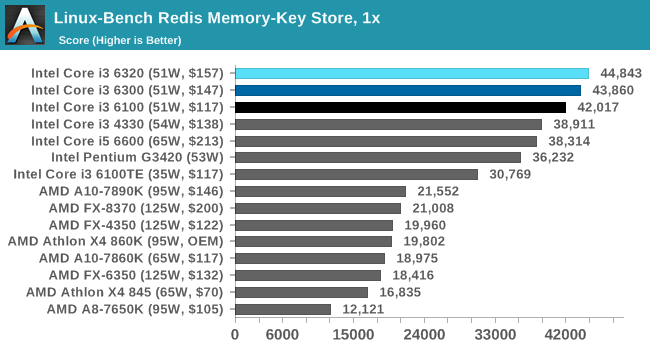

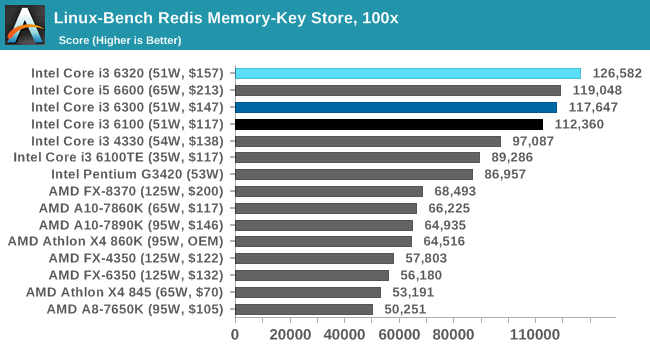
Redis is similar - high IPC and lots of fast cache are needed, and again it seems to be Intel tuned. The i5 sits below the set of Core i3s until the 100x loading comes along, where having physical cores and more cache seems to help. Despite saying more cache seems to help, the effect of the lower L3 cache on the i3-6100 seems to matter more in the 1x and 10x tests, but less in the 100x test, which is somewhat odd.










94 Comments
View All Comments
tipoo - Monday, August 8, 2016 - link
Looks like even a Skylake i3 may be able to retire the venerable 2400/2500K, higher frame rates and better frame times at that. However a native quad does prevent larger dips.Kevin G - Monday, August 8, 2016 - link
I have a feeling much that is due to the higher base clock on the SkyLake i3 vs. the i5 2500K. Skylake's IPC improvements also help boost performance here too.The real challenge is if the i3 6320 can best the i5 2500k as the same 3.9 Ghz base clock speed. Sandy Bridge was a good overclocker so hitting those figures shouldn't be difficult at all.
tipoo - Monday, August 8, 2016 - link
That's true, overclocked the difference would diminish. But you also get modernities like high clocked DDR4 in the switchover.At any rate, funny that a dual core i3 can now fluidly run just about everything, it's two cores are probably faster than the 8 in the current consoles.
Lolimaster - Monday, August 8, 2016 - link
Benchrmarks don't tell you about the hiccups when playing with a dual core. Specially with things like Crysis 3 or even worse ROt Tomb Raider where you get like half the fps just by using a dual core bs a cheapo Athlon 860K.gamerk2 - Monday, August 8, 2016 - link
That's why Frame Times are also measured, which catches those hitches.Samus - Tuesday, August 9, 2016 - link
I had a lot of issues with my Sandy Bridge i3-2125 in Battlefield 3 circa 2011 with lag and poor minimum frame rates.After long discussions on the forums, it was determined disabling hyper threading actually improved frame rate consistency. So at least in the Sandy Bridge IPC, and probably dating back to Nehalem or even Prescott, Jackson Technology or whatever you want to call it, has a habit of stalling the pipeline if there are too many cache misses to complete the instruction. Obviously more cache resolves this, so the issue isn't as prominent on the i7's, and it would certainly explain why the 4MB i3's are more consistent performers than the 3MB variety.
Of course the only way to prove if hyper threading is causing performance inconsistency is to disable it. It'd be a damn unique investigation for Anandtech to do a IPC improvement impact on it's affect on hyper-threading performance over the years, perhaps even dating back to the P4.
AndrewJacksonZA - Wednesday, August 10, 2016 - link
HOW ON EARTH DID I MISS THIS?!?!Thank you for introducing me to Intel's tech known as "Jackson!" This is now *SO* on my "To Buy" list!
Thank you Samus! :-D
bug77 - Monday, August 8, 2016 - link
Neah, I went i5-2500k -> i5-6600k and there's no noticeable difference. The best part of the upgrade was those new I/O ports on the new motherboard, but it's a sad day when you upgrade after 4 years and the most you have to show is you new M2 or USB 3.1 ports (and USB 3.1 is only added through a 3rd party chip).Sure, if I bench it, the new i5 is faster, but since the old i5 wasn't exactly slow, I can't say that I see a significant improvement.
Now, if you mean that instead of getting an i5-2500k one can now look at a Skylake i3, I'm not going to argue with you there. Though (money permitting) the boost speed might be nice to have anyway.
Cellar Door - Monday, August 8, 2016 - link
This is a poorly educated comment:a) Your perceived speed might be limited by your storage
b) You don't utilize your cpu's multitasking abilities fully(all cores)
Duckeenie - Monday, August 8, 2016 - link
Why did you continue to post your comment if you believed you were making poorly educated points?